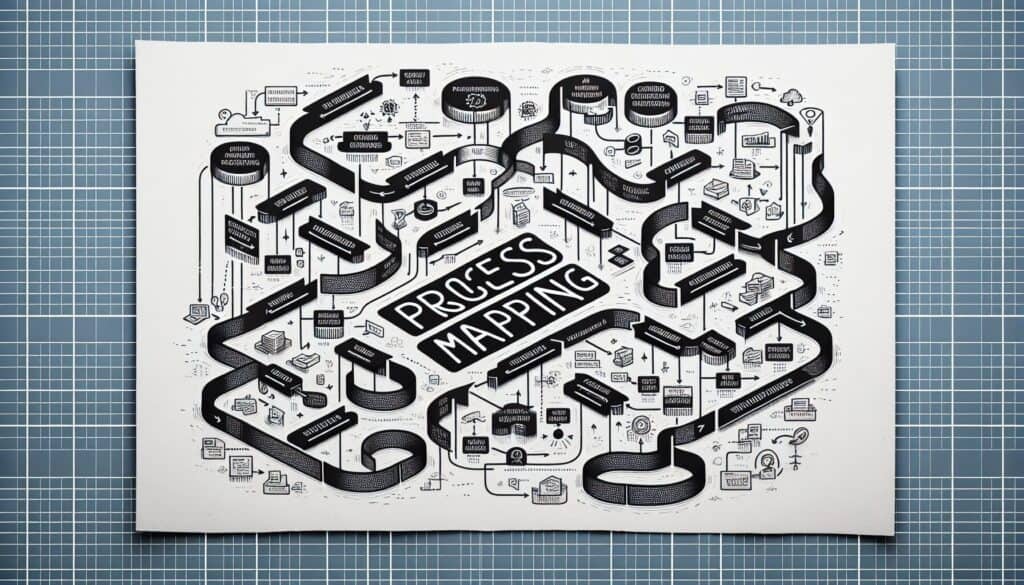Visuelle Darstellung der Abfolge von Aktivitäten, Entscheidungen und des Informationsflusses innerhalb eines Prozesses, um den aktuellen Zustand zu verstehen und verbesserungswürdige Bereiche zu identifizieren.
- Methodologien: Projektmanagement
Prozessabbildung

Prozessabbildung
- Geschäftsprozess-Reengineering (BPR), Kontinuierliche Verbesserung, Schlanke Fertigung, Prozessverbesserung, Prozessabbildung, Prozess-Optimierung, Projektmanagement, Qualitätsmanagement, Wertstrom-Mapping
Zielsetzung:
Wie es verwendet wird:
- Dabei werden alle Schritte in einem Prozess identifiziert, wer sie ausführt und wie sie miteinander verbunden sind. Anschließend wird ein Diagramm (z. B. Flussdiagramm, Swimlane-Diagramm) mit standardisierten Symbolen erstellt.
Vorteile
- Ermöglicht ein klares visuelles Verständnis komplexer Prozesse; hilft bei der Ermittlung von Engpässen, Redundanzen und Ineffizienzen; erleichtert die Kommunikation und Zusammenarbeit zwischen den Beteiligten; bildet eine Grundlage für Prozessverbesserungen.
Nachteile
- Kann bei komplexen Prozessen zeitaufwändig sein; statische Darstellung erfasst möglicherweise keine dynamischen Prozessvariationen; erfordert für die Genauigkeit eine aktive Beteiligung der Prozessverantwortlichen und -beteiligten.
Kategorien:
- Lean Sigma, Herstellung, Problemlösung, Projektmanagement, Qualität
Am besten geeignet für:
- Verständnis der bestehenden Arbeitsabläufe, Ermittlung von Verbesserungsmöglichkeiten, Standardisierung von Prozessen und Schulung.
Process mapping is widely utilized across various sectors, including manufacturing, healthcare, finance, and software development. In manufacturing, it can be employed during the design phase of production systems, enabling teams to visualize the entire manufacturing workflow from raw material procurement to final product delivery, helping to identify potential inefficiencies and areas for automation. In healthcare, process mapping is often initiated by quality assurance teams to visualize patient care paths, thus improving patient outcomes and ensuring compliance with regulatory standards. In the finance sector, process maps are useful for documenting compliance procedures and internal controls, ensuring that all team members understand their roles and responsibilities in maintaining regulatory standards. During project management phases, cross-functional teams collaborate to create these diagrams, ensuring that all stakeholders have a shared understanding of workflows. Training initiatives also benefit significantly, as onboarding new employees with visual aids aids retention and provides clarity, reducing training time. Various tools can be employed for creating diagrams, including software like Microsoft Visio, Lucidchart, or specialized process mapping tools that enhance collaboration and allow for continuous updates as processes evolve. The visualization of workflows through process mapping empowers teams to continuously refine operations, supports Änderungsmanagement initiatives, and enhances overall organizational efficacy.
Die wichtigsten Schritte dieser Methodik
- Identify the process boundaries, defining the start and end points of the process.
- List all steps involved in the process in sequential order.
- Assign roles and responsibilities to individuals or teams for each step.
- Outline connections and interactions between steps to display dependencies.
- Select appropriate standardized symbols and notation for the diagram.
- Create a visual representation of the process using the chosen diagram type.
- Validate the process map with stakeholders for accuracy and completeness.
- Identify areas of redundancy, bottlenecks, or inefficiencies within the map.
- Document any recommended changes and improvements based on findings.
- Update and maintain the process map regularly to reflect ongoing changes.
Profi-Tipps
- Involve cross-functional teams during the mapping sessions to ensure diverse perspectives and a comprehensive understanding of workflows.
- Regularly review and update process maps to reflect changes in practices, technologies, or organizational structure, maintaining relevance and accuracy.
- Leverage process mapping software for advanced features like version control, collaboration tools, and integration with other project management systems to enhance usability.
Verschiedene Methoden lesen und vergleichen, Wir empfehlen die
> Umfassendes Methoden-Repository <
zusammen mit den über 400 anderen Methoden.
Ihre Kommentare zu dieser Methodik oder zusätzliche Informationen sind willkommen auf der Kommentarbereich unten ↓ , sowie alle ingenieursbezogenen Ideen oder Links.
Historischer Kontext
1949
1950
1950
1960
1960
1960
1960
1940
1950
1950
1958
1960
1960
1960
1960
(wenn das Datum nicht bekannt oder nicht relevant ist, z. B. "Strömungsmechanik", wird eine gerundete Schätzung des bemerkenswerten Erscheinens angegeben)















Verwandte Artikel
Fragebögen zu muskuloskelettalen Beschwerden
Multivariate Tests (MVT)
Mehrfache Regressionsanalyse
Motion-Capture-Systeme
MoSCoW-Methode
Moods Median-Test